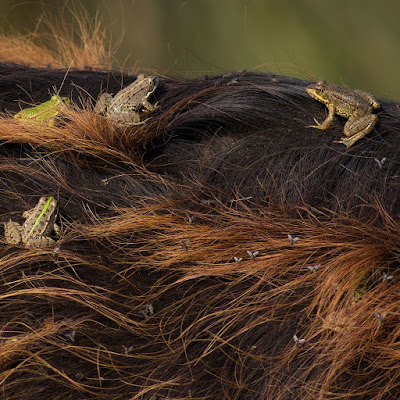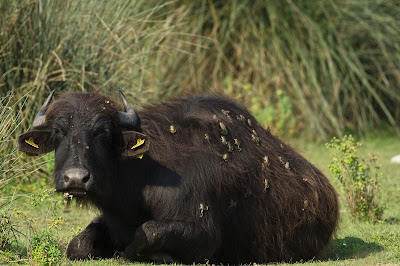 |
| Flowers, fruit, and pollinator of Glochidion lanceolarium. |
Abstract
Leafflower plant/leafflower moth brood pollination mutualisms are widespread in the Paleotropics. Leafflower moths pollinate leafflower plants, but their larvae consume a subset of the hosts’ seeds. These interactions are highly phylogenetically constrained: six clades of leafflower plants are each associated with a unique clade of leafflower moths (Epicephala). Here, we report a previously unrecognized basal seventh pollinating Epicephala lineage—associated with the highly derived leafflower clade Glochidion—in Asia. Epicephala lanceolaria is a pollinator and seed predator of Glochidion lanceolarium. Phylogenetic inference indicates that the ancestor of E. lanceolaria most likely shifted onto the ancestor of G. lanceolarium and displaced the ancestral allospecific Epicephala pollinator in at least some host populations. The unusual and apparently coadapted aspects of the G. lanceolarium/E. lanceolaria reproductive cycles suggest that plant-pollinator coevolution may have played a role in this displacement and provide insights into the dynamics of host shifts and trait coevolution in this specialized mutualism.
Keywords: Epicephala, Glochidion, host shift, intimate mutualism, specialized pollination, coadaptation.
 |
| Figure 1: Flowers, fruit, and pollinator of Glochidion lanceolarium. A, Glochidion lanceolarium individual bearing many fruits and flower buds. B, Male flower. C, Female flowers. D, Female Epicephala lanceolaria moth visiting a male flower. E, Epicephala lanceolaria actively pollinating a female flower. F, Ovipositing E. lanceolaria. G, Pollinated stigma, showing the pollen grains on the stigma. H, Cross section of a female flower with three eggs (arrows). I, Proboscis of a female E. lanceolaria moth bearing pollen. J, Epicephala lanceolaria pupa in a carpel chamber without cocoon. K, Epicephala lanceolaria cocoon in a carpel chamber with a pupa inside. L, Cross section of a mature fruit with two eclosed E. lanceolaria in the carpel chamber. DOI: 10.1086/690623 |
Shi-Xiao Luo, Gang Yao, Ziwei Wang, Dianxiang Zhang and David H. Hembry. 2017. A Novel, Enigmatic Basal Leafflower Moth Lineage Pollinating A Derived Leafflower Host Illustrates the Dynamics of Host Shifts, Partner Replacement, and Apparent Coadaptation in Intimate Mutualisms. The American Naturalist. DOI: 10.1086/690623
Plant keeps moths captive inside its fruits for almost a year
newscientist.com/article/2119346-plant-keeps-moths-captive-inside-its-fruits-for-almost-a-year/
newscientist.com/article/2119346-plant-keeps-moths-captive-inside-its-fruits-for-almost-a-year/
http://www.amnat.org/an/newpapers/AprLuo.html
The Pollination Mutualism between Epicephala moths of Gracillariidae and Glochidion plants of Euphorbiaceae
---------------------------------------------------------------
روابط التحميل والمشاهدة، الروابط المباشرة للتحميل
او
شاهد هذا الفيديو القصير لطريقة التحميل البسيطة
كيف تحصل على مدونة جاهزة بآلاف المواضيع والمشاركات من هنا
شاهد قناة منتدى مدونات بلوجر جاهزة بألاف المواضيع والمشاركات على اليوتيوب لمزيد من الشرح من هنا
رابط مدونة منتدى مدونات بلوجر جاهزة بآلاف المواضيع والمشاركات في أي وقت حــــتى لو تم حذفها من هنا
شاهد صفحة منتدى مدونات بلوجر جاهزة بألاف المواضيع والمشاركات على الفيس بوك لمزيد من الشرح من هنا
شاهد صفحة منتدى مدونات بلوجر جاهزة بألاف المواضيع والمشاركات على الفيس بوك لمزيد من الشرح من هنا
تعرف على ترتيب مواضيع منتدى مدونات بلوجر جاهزة بآلاف المواضيع والمشاركات (حتى لا تختلط عليك الامور) من هنا
ملاحظة هامة: كل عمليات تنزيل، رفع، وتعديل المواضيع الجاهزة تتم بطريقة آلية، ونعتذر عن اي موضوع مخالف او مخل بالحياء مرفوع بالمدونات الجاهزة بآلاف المواضيع والمشاركات، ولكم ان تقوموا بحذف هذه المواضيع والمشاركات والطريقة بسيطة وسهلة. ــــــــــــــــــــــــــــــــــــــــــــــــــــــــــــــــــــــــــــــسلامـ.














